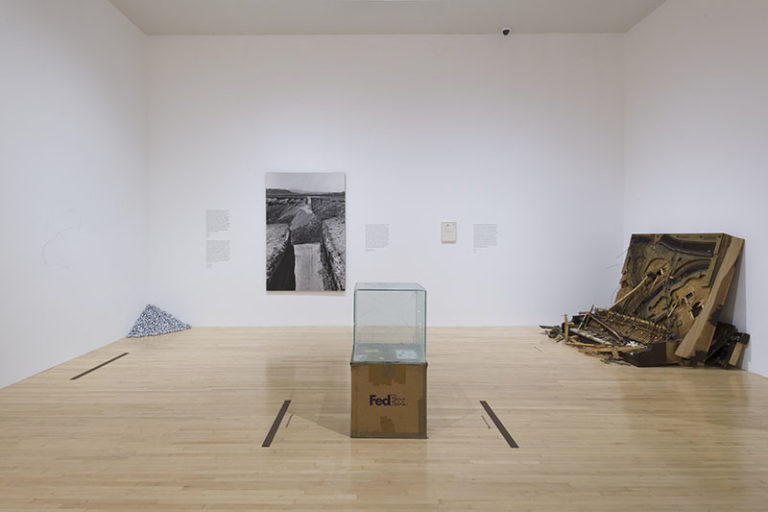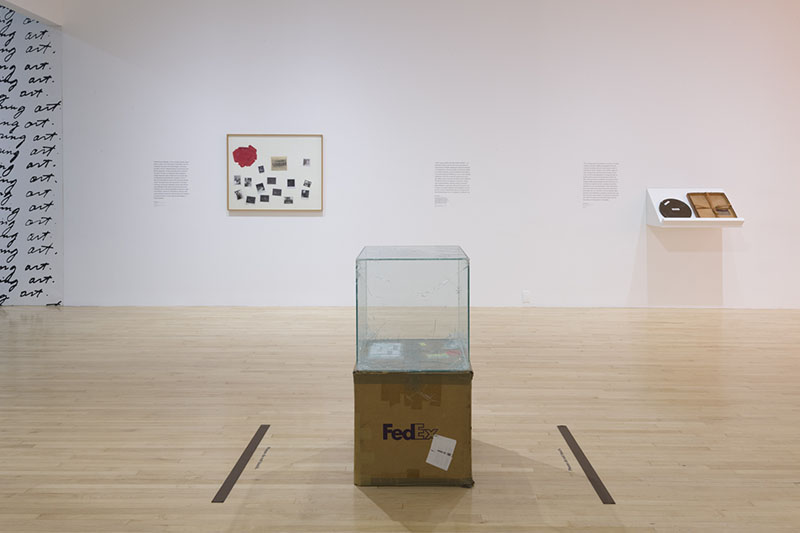The urgency of revisiting an archive is found in challenging its presumed objectivity and totalizing vision, thus exposing cracks, biased ideologies, contradictions and gaps to make way for fracturing, reinterpreting, enlarging or otherwise revising our understanding. Gala Porras-Kim, an artist whose trenchant critique of the archive as a system constructed to sustain colonization has been central to her installations—Made in L.A. 2016, the PST: LA/LA exhibition A Universal History of Infamy, and the Whitney Biennial 2019—has undertaken to curate MOCA’s second “Open House,” a series in which Los Angeles-based artists are invited to curate from the museum’s extensive collection of contemporary art.
Even with Porras-Kim’s evident seriousness in curating, with help from MOCA’s Assistant Curator and Manager of Publications Bryan Barcena and Curatorial Assistant Karlyn Olvido, the results are mixed. Whereas her installation in A Universal History of Infamy, which mounted a critique of how knowledge had been constructed from incomplete information of objects in LACMA’s collection, was pointed, “Open House” remains diffuse, and even anticlimactic.

Installation view of Open House: Gala Porras Kim. Walead Beshty’s FedEx® Large Kraft Box … (2009) and Michael Heizer’s Double Negative (1969-1970). Courtesy of The Museum of Contemporary Art. Photo by Jeff Mclane.
Porras-Kim’s curation of “Open House” is an open-ended inquiry into the mutability of MOCA’s collection that coalesces into a loose thesis about the permanent collection’s lack of permanence. The exhibition examines a series of ephemeral works that are transient because of the materials of their construction, alongside ones whose foreclosure is intended. In the first category, a collaged work on paper, Chris Burden’s Peace (1982) makes use of non-archival adhesives and unstable materials such as Polaroids, cigarette wrappers, newspaper and cellophane—focusing attention on objects in the collection that cannot be conserved, because their materials will crumble into dust.
Richard Tuttle’s 44th Wire Piece (1972/2014) falls into the second category. Unlike Sol LeWitt’s wall drawings, Tuttle’s instructions state that he alone may install the piece. One can infer from its accompanying didactic that the museum might be considering approaching Tuttle to request an alteration, allowing for others to install when the artist becomes incapacitated or deceased. One can imagine internal discussions pursuant to avoiding the loss of never being able to exhibit the Tuttle again, after an indeterminate date looming in the foreseeable future, in distinction to the original conceptual parameters of the artwork.
Michael Heizer’s Double Negative (1969–70) presents a similar conundrum. Heizer’s original intent to allow the land art piece to recede into the desert as erosion requires that we orientate to a planetary, geologic time-frame and ask ourselves whether any of the monuments humans have constructed will remain after we have gone. As noted in the didactic, he has since changed his mind and communicated his desire to conserve the work. MOCA, perhaps tellingly, states that these kinds of contradictions “can be points of negotiation between institutions and artists.”
Two additional works in “Open House” suggest ways this exhibition might have been pushed toward a more pointed thesis. The first, Walead Beshty’s FedEx® Large Kraft Box … (2009), a shatterproof glass cube and FedEx® shipping box, suggests a new kind of Vanitas object, in which an insider’s view of the international art circuit reveals the self-referential logic and surfeit of the prevailing system of exhibition and consumption of art.
Wolfgang Laib’s pollen field works, represented here by Pollen from Dandelions (1978), offer a reprise to Heizer’s referencing of geologic time and the implicit rebuke therein. Laib’s work involves a radical consideration and empathy for non-human beings; his process of gathering pollen and his deeply held respect for nature propose ways to decenter the human. The effect of understanding Laib’s process is likely to produce an understanding of the expansiveness of his gesture, which condenses the experience of interacting with plants in a ceremonial way, and its link to seasonal cycles and reproduction.
This final direction would fortify Porras-Kim’s “Open House” with a powerful critique of the archive as an index of institutional interests and the hegemony of human systems. Further investigation of MOCA’s thinking on the permanence of the collection would be instructive, especially regarding objects that may be the subject of renewed negotiation, as related to weighing MOCA’s interests and the value of the collection against the conceptual coherence of the works. But most compelling would be to make explicit the way the objects exhibited in “Open House” advance ideas of decentering the human, which would call into question the archive in its entirety.











0 Comments